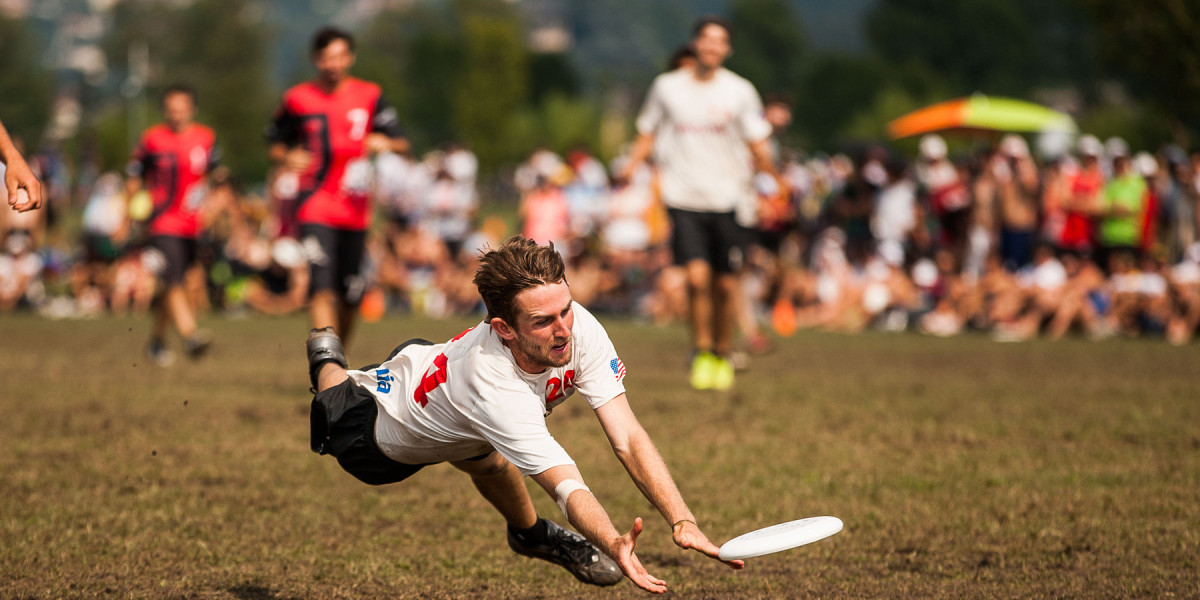 Neil Gardner - UltiPhotos.com
Neil Gardner - UltiPhotos.com
I’ve started to notice a scary tendency when players make layout grabs. It can be pretty subtle and easy to miss during the excitement of an awesome play, but I’m sure this problem has existed for as long as our sport has.The first time I noticed it was on one particular layout catch made by an Oregon player early in the semifinals against Central Florida at this year’s College Nationals.
What I’m referring to is a startling amount of cervical flexion– the forward bending of a person’s neck — caused by the momentum of a player’s head right after they hit the ground. It very much resembles a “whiplash” injury, which is a soft-tissue injury (muscle, tendon, ligament) one receives when their head gets whipped back and forth, often happening when cars get rear-ended.
While I’m operating with a relatively small sample size of videos, this issue appears to be much more severe with women’s ultimate than men’s. I believe the reason is simple: women have less muscle mass than men, which generally means less overall strength. That being said, if you watch some highlights of the men’s game, you can see that the same thing is happening. It’s less apparent, but in my mind, no less of an issue.
To my knowledge, no one in our sport has had a major head or neck injury due to this specific mechanism. But I do think the risk is increasing simply because the sport is growing. Researchers call this statistic athletic exposures.
There are several sports injuries that could result from a significant torque to the cervical spine. I’ve already mentioned the first, whiplash, which is relatively minor when it comes to neck injuries. Still, if it’s bad enough, it can sideline someone for months.
Beyond whiplash, excessive neck flexion can cause cervical disk herniations, which are basically ruptures in the disks found in between the vertebrae. The ruptures allow the inner contents to escape and press into the nerves, leading to pain and dysfunction. These are pretty rare compared to lumbar herniations, which have the same concept but happen in the low back, but all forms of disk injuries result from repetitive, long-term stresses rather than a single big one. So if these excessive forces to the neck become a habit then problems can arise down the road.
Also, concussions. Given that we don’t tackle each other in ultimate, I’d bet that most concussions happen when a player’s head hits the ground. If you are a coach or leader on your team, I strongly suggest you familiarize yourself with concussion signs and symptoms. This is becoming a very big deal in sports (rightfully so), and if one of your players presents with concussion-like symptoms, have them de-cleat immediately. After that, they should see a physician as soon as they can.
Finally, spinal cord injuries. A sufficient force to the neck can fracture the vertebrae, which can put the spinal cord itself at risk for injury. If a neck fracture is ever suspected, the first priority on the field is to have an individual hold the the head and neck still in the position it was found until help arrives. The only exception is if the player isn’t breathing, at which point CPR is the priority.
Fortunately this problem can be addressed pretty easily with simple strengthening of the neck muscles. To borrow a little bit from other articles on Skyd, Tim Morrill has made really good points in regards to a global extension pattern during jumping and laying out, and neck extensor muscles are part of the entire posterior chain and contribute to a globally extended position. Also, Ren Caldwell had a great discussion on reactive core training, and I believe reactive neck training can be thought of in the same way. I recommend an easy progression:
First, assume a good head posture while seated. Your nose should be pointed straight forward and your ears should be directly above your shoulder. A good cue for this is “try to make a double chin.” It’s often called a chin tuck position. From there, do isometric holds with force from the front, back, and each side. 5-8 second holds are fine, and you should do three sets of 8-10 reps. This can be done with a towel, resistance band, or even your hands. This article illustrates these exercises pretty well.
Second, since players lay out while looking forward, it is important to strengthen the neck extensors while the neck itself is extended. So if you’re seated, look overhead and apply the same isometric resisted exercise as described above.
Lastly, with sport-specific training in mind I think it’s important to replicate a layout scenario while doing these exercises. Since concussions often happen during the “sucker-punch” scenario when a player doesn’t see a hit coming and can’t brace their neck for the impact, athletes should incorporate neck extension resistance while replicating a layout scenario. This can be achieved by doing bird dogs or other prone exercises. You can try alternating arms and legs while balancing a weight behind your head, or just have a buddy apply resistance. If you do use a buddy, have them change the angle of their force throughout the exercise. This mimics a global extension pattern where you have to react to varying angles of force.








Comments Policy: At Skyd, we value all legitimate contributions to the discussion of ultimate. However, please ensure your input is respectful. Hateful, slanderous, or disrespectful comments will be deleted. For grammatical, factual, and typographic errors, instead of leaving a comment, please e-mail our editors directly at editors [at] skydmagazine.com.